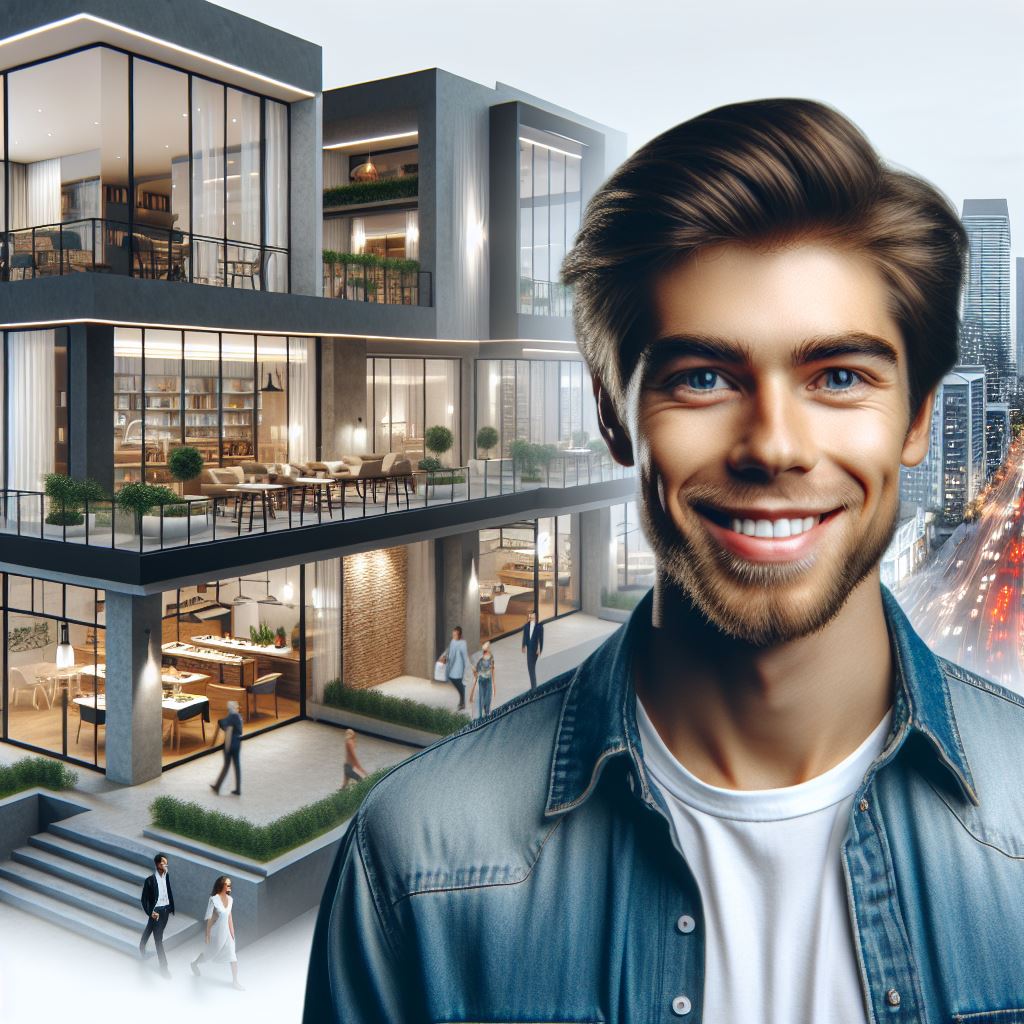Introduction
Mixed-use properties have become increasingly popular in the US market in recent years.
These properties combine residential, commercial, and often retail spaces into one development.
They offer a convenient and efficient way of living, allowing people to live, work, and shop all in one location.
The concept of mixed-use properties is not new and has been around for centuries. In fact, it dates back to ancient times when people lived above their businesses.
However, in the US, mixed-use development gained popularity in the early 20th century, particularly in urban areas.
Historically, many cities had separate zoning regulations that divided residential and commercial areas.
However, as urbanization increased, the demand for more integrated and convenient spaces grew.
This led to a shift in zoning policies and the rise of mixed-use development.
Today, mixed-use properties can be found not only in urban areas but also in suburban communities. There are several advantages to mixed-use properties.
They promote walkability, as residents can easily access shops, services, and employment opportunities within their community.
This reduces the need for long commutes and contributes to a more sustainable lifestyle.
Additionally, mixed-use properties can create a sense of community and foster social interaction among residents and businesses.
Furthermore, mixed-use properties can benefit the local economy by attracting businesses, creating jobs, and generating tax revenue.
They also have the potential to revitalize and enhance neighborhoods, making them more vibrant and appealing.
In essence, mixed-use properties have become a significant trend in the US market.
They offer a unique and convenient lifestyle, promote sustainability, and contribute to the local economy.
As urbanization continues, the demand for mixed-use development is likely to rise even further.
Factors driving the rise of mixed-use properties
Changing demographics and lifestyles
The rise of mixed-use properties can be attributed to the changing demographics and lifestyles of Americans.
In recent years, there has been a shift in preferences towards living in urban areas among millennials and young professionals.
These demographics value the convenience and accessibility that mixed-use properties offer.
Furthermore, there has been an increase in the number of single-person households, which also contributes to the demand for smaller, more convenient living spaces.
As a result, developers have recognized the market potential of mixed-use properties and have started incorporating residential units alongside commercial spaces.
This allows residents to live, work, and socialize all within the same neighborhood.
Additionally, mixed-use properties often include amenities such as fitness centers, restaurants, and entertainment venues, which cater to the changing lifestyles of urban dwellers.
Demand for convenience and walkability
Another factor driving the rise of mixed-use properties is the increasing demand for convenience and walkability.
Americans are seeking to reduce their reliance on cars and embrace a more sustainable lifestyle.
Mixed-use developments, with their proximity to shops, restaurants, and offices, allow residents to walk or bike to their destinations, reducing the need for excessive driving.
By promoting pedestrian-friendly environments, mixed-use properties contribute to the overall well-being and health of the community.
This convenience factor also appeals to the aging population, who prefer living in walkable neighborhoods with easy access to essential services and amenities.
Urban revitalization efforts
Mixed-use properties play a vital role in urban revitalization efforts across cities in the United States.
Once-neglected urban areas are being transformed into vibrant and economically sustainable neighborhoods through mixed-use developments.
By combining residential, commercial, and retail spaces, these properties attract businesses, residents, and visitors, injecting new life into previously stagnant areas.
This revitalization has numerous benefits, including increased employment opportunities, improved property values, and enhanced quality of life for residents.
Furthermore, mixed-use properties encourage the preservation and adaptive reuse of historic buildings, contributing to the cultural and architectural diversity of the city.
Benefits for sustainable development and reducing carbon footprint
Mixed-use properties also offer significant benefits for sustainable development and reducing the carbon footprint.
By consolidating various activities within a single development, these properties promote efficient land use and reduce urban sprawl.
This compact, mixed-use model encourages the use of public transportation and minimizes the need for long commutes.
Additionally, mixed-use properties often incorporate sustainable design features such as green spaces, energy-efficient systems, and alternative energy sources.
These initiatives contribute to the reduction of greenhouse gas emissions and the overall environmental impact of the community.
Furthermore, mixed-use properties create opportunities for residents to participate in sustainable practices, such as recycling programs and community gardening.
In fact, the rise of mixed-use properties in the US market can be attributed to changing demographics, demand for convenience and walkability, urban revitalization efforts, and their benefits for sustainable development.
These properties cater to the evolving lifestyles of Americans, promote efficient land use, and contribute to the overall well-being of communities.
As cities continue to grow and evolve, mixed-use properties are poised to play an integral role in shaping sustainable and vibrant urban environments.
Read: Sustainable Living: US Market Adapts
Economic Advantages of Mixed-Use Properties
In recent years, there has been a notable rise in the popularity of mixed-use properties within the US market.
These properties, which combine residential, commercial, and often recreational spaces, offer numerous economic advantages for both property owners and tenants.
Boosting Property Value and Rental Income
Mixed-use properties have the potential to significantly boost property values due to their diverse functionality and appeal.
By incorporating both residential and commercial spaces, these properties attract a wider range of potential buyers and tenants.
The demand for mixed-use properties often results in higher rental income, as businesses and residents are willing to pay a premium for the convenience they offer.
Diversification of Revenue Streams
Owning a mixed-use property provides a unique opportunity to diversify revenue streams.
With residential units, commercial spaces, and possibly even recreational amenities, property owners have multiple sources of income.
Even during economic downturns, when one sector may experience a slump, the other sectors can help offset potential losses.
Cost Savings through Shared Resources and Infrastructure
Mixed-use properties offer cost-saving benefits by sharing resources and infrastructure between residential and commercial components.
For example, shared parking facilities can reduce the overall number of parking spaces required, saving on construction costs.
Similarly, heating, cooling, and maintenance expenses can be shared among various tenants, resulting in lower operational costs.
Furthermore, the close proximity of commercial and residential spaces in mixed-use developments often encourages walking and the use of public transportation.
This, in turn, reduces transportation costs for residents and contributes to a greener environment.
Attractiveness to Millennials and Young Professionals
Mixed-use properties are particularly attractive to millennials and young professionals.
These individuals often seek a live-work-play lifestyle, where they can reside, work, and have recreational amenities all within a short distance.
By offering a vibrant and convenient environment, mixed-use properties can attract this demographic, leading to a higher demand and increased property value.
Enhanced Community Engagement and Integration
Mixed-use properties contribute to the development of strong communities by integrating various activities and promoting interaction among residents and businesses.
Residents have easy access to local businesses, schools, parks, and other amenities, fostering a sense of belonging and community involvement.
Moreover, the diverse activities found within mixed-use properties create opportunities for social engagement and networking.
In short, the rise of mixed-use properties in the US market presents numerous economic advantages.
These properties not only boost property value and rental income but also offer diversification of revenue streams and cost savings through shared resources.
Their appeal to millennials and young professionals, as well as the enhanced community engagement they foster, solidify their economic viability and attractiveness in today’s market.
Read: Real Estate Tech: Transforming US Homes
Different types of mixed-use properties
There has been a growing trend in the US market for mixed-use properties, which combine different types of spaces in a single development.
These properties offer a range of amenities and benefits to residents, workers, and visitors, making them highly sought after in major cities across the country.
Residential and retail combinations
These mixed-use properties typically feature a combination of residential units, such as apartments or condos, and retail spaces.
The retail spaces can include shops, restaurants, cafes, and other commercial establishments.
This combination creates a vibrant and convenient living environment for residents, with easy access to essential amenities and services.
Residential and office combinations
These mixed-use properties combine residential units with office spaces.
This type of development is ideal for individuals who work from home or desire a live-work environment.
It offers the convenience of having offices within the same building or complex, reducing commuting times and increasing productivity.
Residential, retail, and office combinations
Some mixed-use projects incorporate all three elements – residential, retail, and office spaces.
These developments create a truly integrated community where residents can live, work, and access various services all within one central location.
They often include shared amenities, such as parks, plazas, and recreational facilities, to further enhance the sense of community.
Examples of successful mixed-use projects in major US cities
Hudson Yards, New York City
Located on Manhattan’s West Side, Hudson Yards is the largest private real estate development in the history of the United States.
It features a mix of residential, retail, and office spaces, including luxury apartments, high-end stores, and iconic office towers.
The development has transformed the once-abandoned rail yards into a vibrant neighborhood.
The Grove, Los Angeles
Situated in the heart of Los Angeles, The Grove is a popular mixed-use complex that combines residential units, retail stores, and entertainment venues.
The property is known for its beautifully landscaped outdoor mall and signature trolley, which transports visitors through the retail area.
It has become a major tourist attraction in the city.
The Wharf, Washington, D.C.
Located along the Potomac River, The Wharf is a waterfront development that offers a blend of residences, restaurants, retail shops, and office spaces.
With its boardwalk, marina, and outdoor concert venue, it has become a vibrant destination for locals and tourists alike, revitalizing the D.C. waterfront.
Ponce City Market, Atlanta
Housed in a historic Sears, Roebuck & Co. building, Ponce City Market is a mixed-use development that combines residential lofts, office spaces, and a variety of retail and dining options.
It has become a thriving hub in Atlanta’s trendy Old Fourth Ward neighborhood, attracting locals and visitors from far and wide.
South Lake Union, Seattle
Once an industrial area, South Lake Union has been transformed into a dynamic mixed-use neighborhood.
The development includes a mix of residential, office, and retail spaces, with a focus on technology and innovation.
It is now home to many major technology companies, contributing to Seattle’s booming tech industry.
In general, mixed-use properties have gained popularity due to their ability to offer a diverse range of spaces and amenities within a single development.
Whether it’s residential and retail combinations, residential and office combinations, or a combination of all three, these properties provide convenience, vibrancy, and community for residents, workers, and visitors alike.
Read: Cost-Efficient Building: 2024 US Insights

Challenges and Considerations for Mixed-Use Development
Developing mixed-use properties comes with various challenges and considerations that need to be addressed to ensure success.
Below are some key factors to consider:
Zoning and Regulatory Barriers
Zoning laws and regulations can pose significant challenges for mixed-use development projects.
Sometimes, local governments have strict zoning restrictions that may hinder the creation of mixed-use properties.
Developers must work closely with city planners and officials to navigate through the regulatory barriers.
Balancing the Needs of Different Stakeholders
Mixed-use developments involve combining residential, commercial, and sometimes industrial spaces.
It is crucial to strike a balance between the needs of residents, businesses, and the overall community.
Engaging stakeholders and soliciting input from various parties can help achieve this balance effectively.
Ensuring Affordability and Inclusivity
Mixed-use properties should strive to offer affordable housing options for residents.
Creating a diverse and inclusive community that caters to people of different income levels is essential.
Developers can explore partnerships with affordable housing organizations or incorporate inclusionary zoning policies.
Addressing Potential Negative Impacts on Neighborhoods
The introduction of mixed-use developments can have both positive and negative effects on neighborhoods.
Increased traffic, noise, and parking issues are some of the potential negative impacts to consider.
Implementing traffic management strategies and ensuring adequate infrastructure can help mitigate these concerns.
In review, the rise of mixed-use properties in the US market offers numerous opportunities for urban development.
However, addressing the challenges and considerations outlined above is crucial to ensure successful and sustainable projects.
By navigating zoning barriers, balancing stakeholder needs, promoting affordability, and managing potential negative impacts, mixed-use developments can contribute positively to the overall livability and vibrancy of neighborhoods.
Read: Prefab Homes: Rising US Market Trends
Tips for investors and developers interested in mixed-use properties
Investing in mixed-use properties can be a lucrative venture, but it requires careful planning and consideration.
Whether you are a first-time investor or an experienced developer, here are some tips to help you navigate the world of mixed-use properties and maximize your success:
1. Conduct market research and feasibility studies
Before diving into any investment or development project, it is crucial to conduct thorough market research and feasibility studies.
This will help you understand the demand and potential profitability of mixed-use properties in your target location.
Analyze trends, economic indicators, and demographics to identify the most promising areas.
2. Understand the local community and its needs
Mixed-use properties are designed to serve the needs of the surrounding community, so it is essential to understand the demographics and preferences of the local residents.
Engage with the community, conduct surveys, and hold public consultations to gather insights into what amenities and services they desire.
This will help you create a development that caters to their specific needs.
3. Engage in effective urban planning and design
Successful mixed-use developments often prioritize efficient urban planning and design.
Consider factors such as traffic flow, accessibility, and the integration of different land uses.
Develop a cohesive and aesthetically pleasing design that enhances the urban fabric and creates an attractive environment for residents, workers, and visitors.
4. Collaborate with experienced professionals and stakeholders
Building and managing mixed-use properties can be complex, so it is beneficial to collaborate with experienced professionals and stakeholders.
Engage with architects, engineers, real estate agents, and property managers who have expertise in mixed-use developments.
Also, involve local government officials, community leaders, and neighboring businesses to gain their support and ensure successful implementation.
5. Create a diverse mix of amenities and services
One of the key advantages of mixed-use properties is the combination of different uses within one development.
To attract a wide range of users, create a diverse mix of amenities and services.
This could include residential units, retail spaces, restaurants, offices, entertainment venues, and public spaces.
The more varied and complementary the offerings, the greater the appeal to potential tenants and customers.
6. Prioritize sustainability and green spaces
In today’s environmentally conscious world, sustainability is a crucial factor in the success of any development.
Incorporate eco-friendly features into your mixed-use project, such as energy-efficient systems, renewable energy sources, and water-saving technologies.
Additionally, prioritize the creation of green spaces, such as parks or rooftop gardens, to enhance the quality of life for residents and promote a healthy environment.
7. Plan for parking and transportation
Mixed-use properties often attract a high volume of people, so it is essential to plan for adequate parking and transportation options.
Evaluate the local transportation infrastructure and consider offering public transportation incentives, bike-sharing programs, or carpooling arrangements.
Additionally, design appropriate parking facilities to accommodate the needs of residents, workers, and visitors.
8. Stay updated on market trends and evolving needs
The real estate market is constantly evolving, and it is crucial to stay updated on the latest trends and changing needs of the community.
Stay informed about emerging technologies, consumer preferences, and regulatory changes.
This will allow you to adapt your mixed-use development strategy to remain competitive and meet the evolving demands of the market.
Investing in mixed-use properties can be a rewarding endeavor, but it requires strategic planning, market knowledge, and collaboration.
By following these tips and understanding the unique needs of the local community, investors and developers can position themselves for success in the rising market of mixed-use properties.
Conclusion: The Future of Mixed-Use Properties in the US Market
Mixed-use properties have experienced a remarkable rise in the US market, and this trend is expected to continue in the future.
With the increasing demand for convenience and work-life balance, these properties offer a perfect solution by combining residential, commercial, and recreational spaces.
The potential for growth and expansion of this real estate trend is immense.
Developers are quick to recognize the advantages of mixed-use properties, as they cater to the needs of a diverse population and maximize land use efficiency.
By providing a range of amenities and services in one location, these properties attract both residents and businesses, creating a self-contained community.
Not only do mixed-use properties offer convenience and efficiency, but they also have a significant impact on the urban landscape and community development.
By revitalizing and repurposing underutilized areas, these properties contribute to the beautification and rejuvenation of neighborhoods.
They promote walkability and interaction among residents, fostering a sense of community and social cohesion.
Adaptability and flexibility are crucial for the long-term success of mixed-use projects.
The ever-changing market demands require developers to anticipate and incorporate new trends and technologies into their designs.
By staying adaptable, these properties can continuously evolve to meet the changing needs of residents and businesses, ensuring sustained success.
Mixed-use properties are poised to dominate the US market in the years to come.
The convenience, efficiency, and community-focused nature of these properties make them highly desirable for both residents and businesses.
As the demand for live-work-play environments continues to grow, developers need to embrace adaptability and flexibility to ensure the long-term success of their projects.




